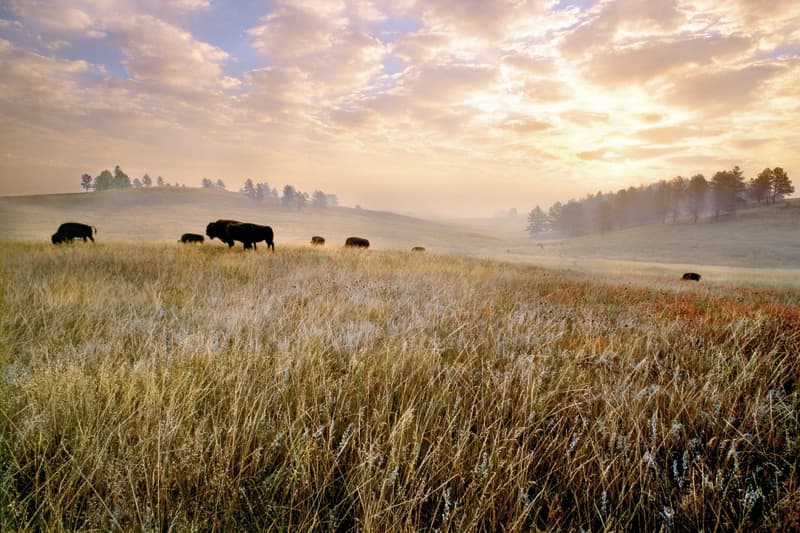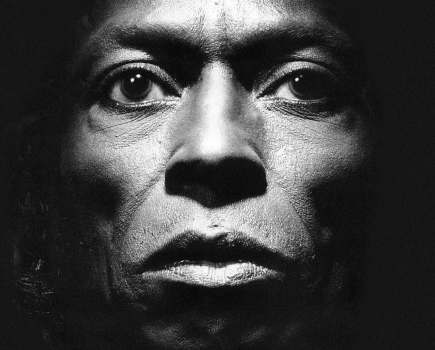Photo Insight with Jim Brandenburg

Jim Brandenburg travelled the world as a photographer with National Geographic magazine for more than 30 years. His work has been published in The New York Times, Life and Time, among others, and he has won numerous awards, including Kodak Wildlife Photographer of the Year by the Natural History Museum and BBC Wildlife Magazine. He is the chair of this year’s competition. Every month Jim will share the story behind one of his nature images
I was on assignment for National Geographic magazine when I made this photograph. I was working on a story about the 500th anniversary of Columbus travelling from Europe to ‘discover America’, although technically the Vikings arrived before Columbus but we won’t go into that now. I wanted to capture the way the prairie might have looked many hundreds of years ago – wild and real.
In 1990, I travelled the United States for this assignment, from one coast to the other for more than a year. It was a golden era for photographers – one could spend months photographing a story, which was an incredible luxury and would be impossible today. Now you might get five weeks [for an assignment] if you’re lucky. The budgets and restrictions are very different in this economic climate. I had complete freedom: the picture editors at National Geographic trusted me; they knew that wilderness landscapes are my speciality. Of all the images I’ve ever shot, some of my favourites were made during this assignment.
My goal was to portray a location without any visible traces of the hand of man – no telephone wires, roads or even jet contrails in the sky. Consequently, I almost always worked in national parks. My aim was to replicate what was there before humans arrived. There is an elusiveness and a mood to this image that I like. I prefer to shoot in interesting weather conditions, whether it be rain, snowfall or fog, as it adds a whole new element to the picture. The foggy atmosphere you see here is a little unusual in that it isn’t actually fog – it is smoke from a large nearby prairie fire that cloaks the landscape, giving it a rather strange look. One can tell it’s not fog because it’s sunny [rather than grey and overcast]. The smoke made the photograph – it creates a wonderful aura for the scene. In fact, without the smoky atmosphere, I might not have even shot the photograph.
Fires were crucial for the regeneration of the prairies. They were fairly frequent occurrences in the wildlands of North America long before humans started populating the land and taking control of the fires. The Native Americans, early settlers and my ancestors talked about these fires. The fire helps to release nutrients into the soil, which helps to keep it fertile. When the grasses grow back after a fire, they do so much richer. When fires were common 500 years ago there were virtually no trees on the prairies, so this image shows what would have been a typical scene.
The prairies are an important part of my life now, even though I live in the deep boreal forest far to the north. Ten years ago I set up the Brandenburg Prairie Foundation to help preserve native prairies. My photography has allowed me to fund raise and protect 1,000 acres of prairie land near my birthplace in Minnesota. I learned my craft on the prairies, a simple land form with few or no trees. Even now I find myself gravitating towards places with no trees, such as deserts and the arctic tundra. The expansiveness of the scene in this image [appeals to me] – you cannot see the distant horizon.

This image was made as one approaches the Black Hills, a small isolated mountain range rising from the Great Plains of North America, in a place called Wind Cave National Park. This location was where I shot one of my first assignments as a young photographer for Time-Life Books. The trees in the background are the very first you see as one travels from the prairie to the Black Hills. This area reminds me of the landscapes of the African savanna – there are animals all around, such as prairie dogs, elk, coyotes and bison. Many photographers choose not to visit this area perhaps because the simple prairie landscape seems ‘empty’. Mount Rushmore with the carved heads of early American presidents near Keystone in South Dakota is only a half hour away and is a more popular destination.
It’s been some time since I made this image so I have to unravel things in my mind and remember how it came about. First, you find a mood, the setting and the light. A lot of photographers think about the equipment first – and this is important – but first you have to walk into the scene and unlock its potential. I shot this in the morning as the sun was rising.
I love using wideangle lenses and I’ve always been fascinated by what one can capture with these. I tend to think ‘wide’ or ‘long’, and the first two lenses I owned were 20mm and 300mm optics. Nearly every scene I encounter I think of in terms of these two extremes. I believe this image was made with a 20mm lens. I used a Nikon camera, although I don’t recall what model it was, and I was using either Kodachrome or Fujichrome Velvia film – I was using both at the time because I couldn’t decide which emulsion I liked best. [Jim explains more about his working processes in our interview with him in AP dated 31 March 2012.]
I would have bracketed my exposure as there was less latitude with those particular emulsions. I probably would have tended more towards underexposing the image as I didn’t want any highlights to be blown out. This shot was made before in-camera meters were at the level they are today. They weren’t as reliable then, so I would always have a handheld lightmeter with me. I wish I could revisit every one of the scenes I’ve ever photographed with a modern digital camera.
One can never be 100% sure you’ve got the shot. There have, of course, been times when I wish I’d stayed a bit longer, but fortunately, there have been many times when I decided to hang on at a location for a few extra minutes and something miraculous has happened. My nature is like that of an animal – I move often and I move quickly. I tend to find that the best opportunities present themselves in this way, but one needs to know when and where to move to. That is the elusive and ultimate question.
To see more of Jim’s images visit www.jimbrandenburg.com
Jim Brandenburg was talking to Gemma Padley







